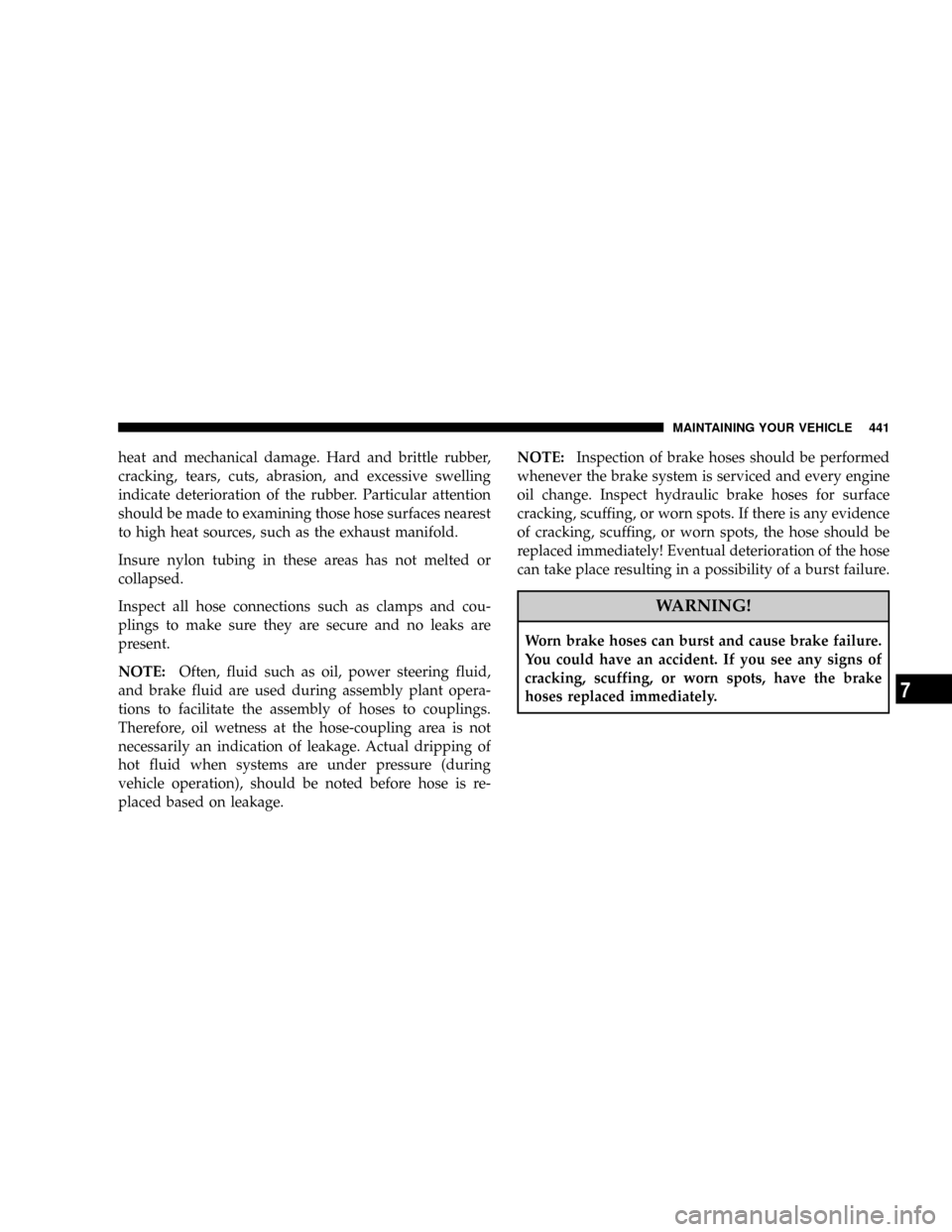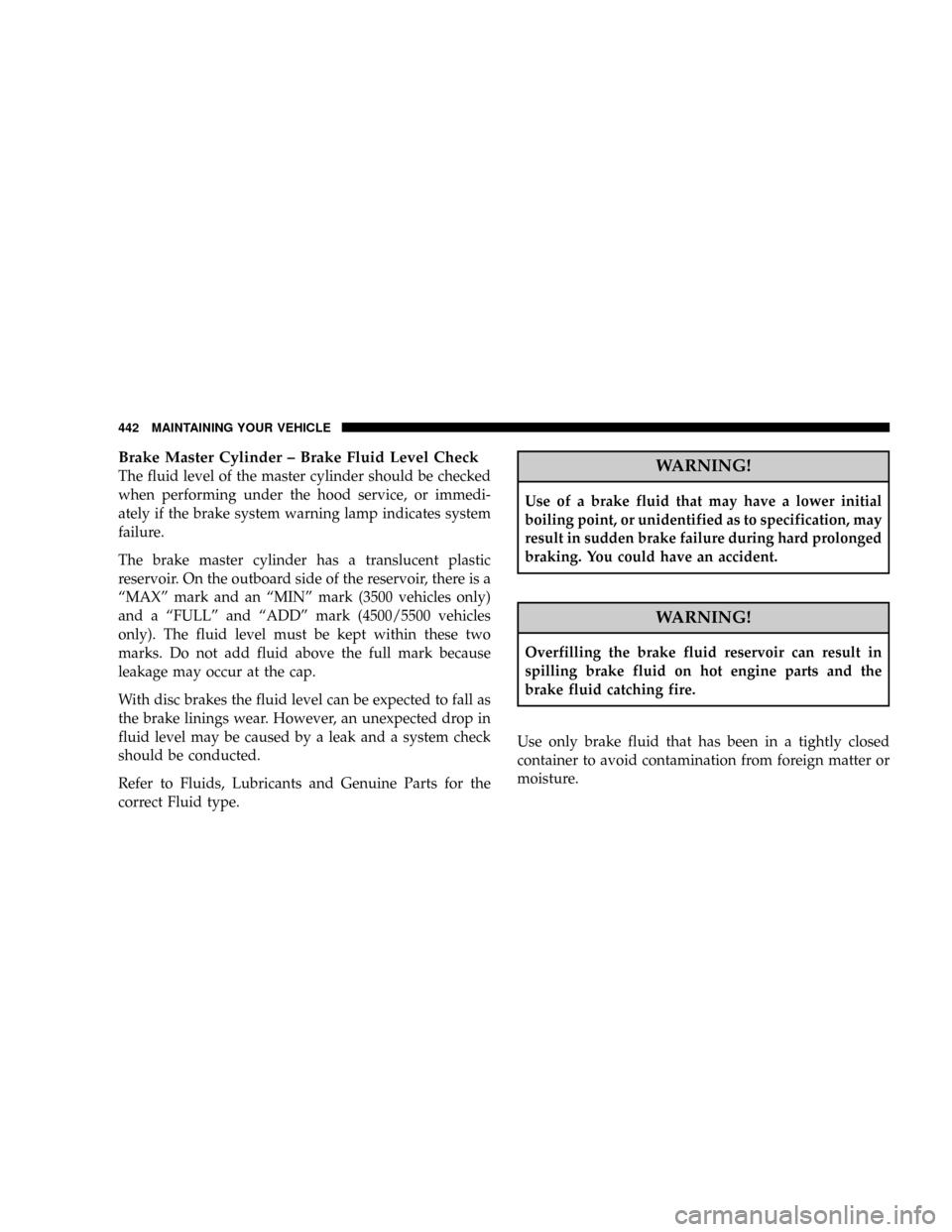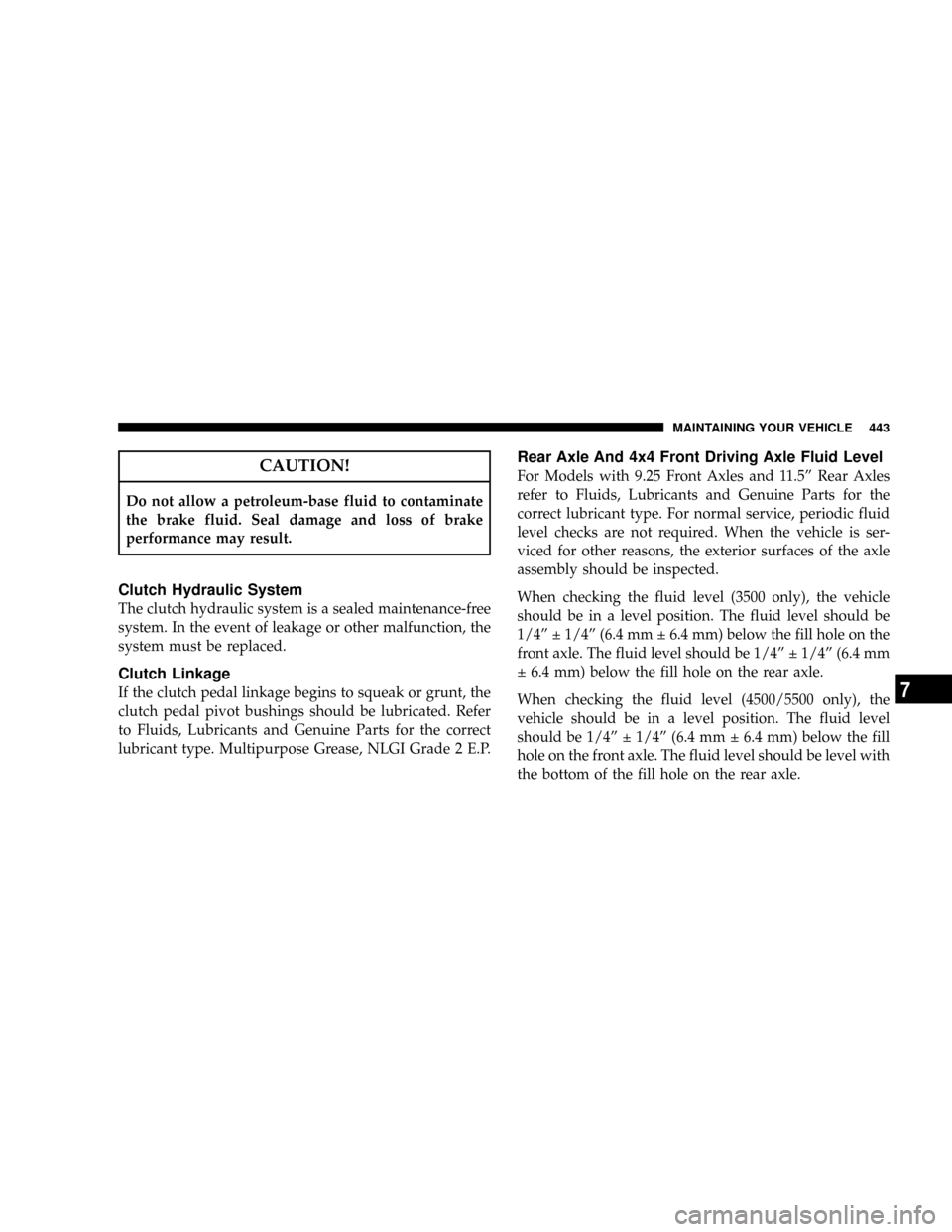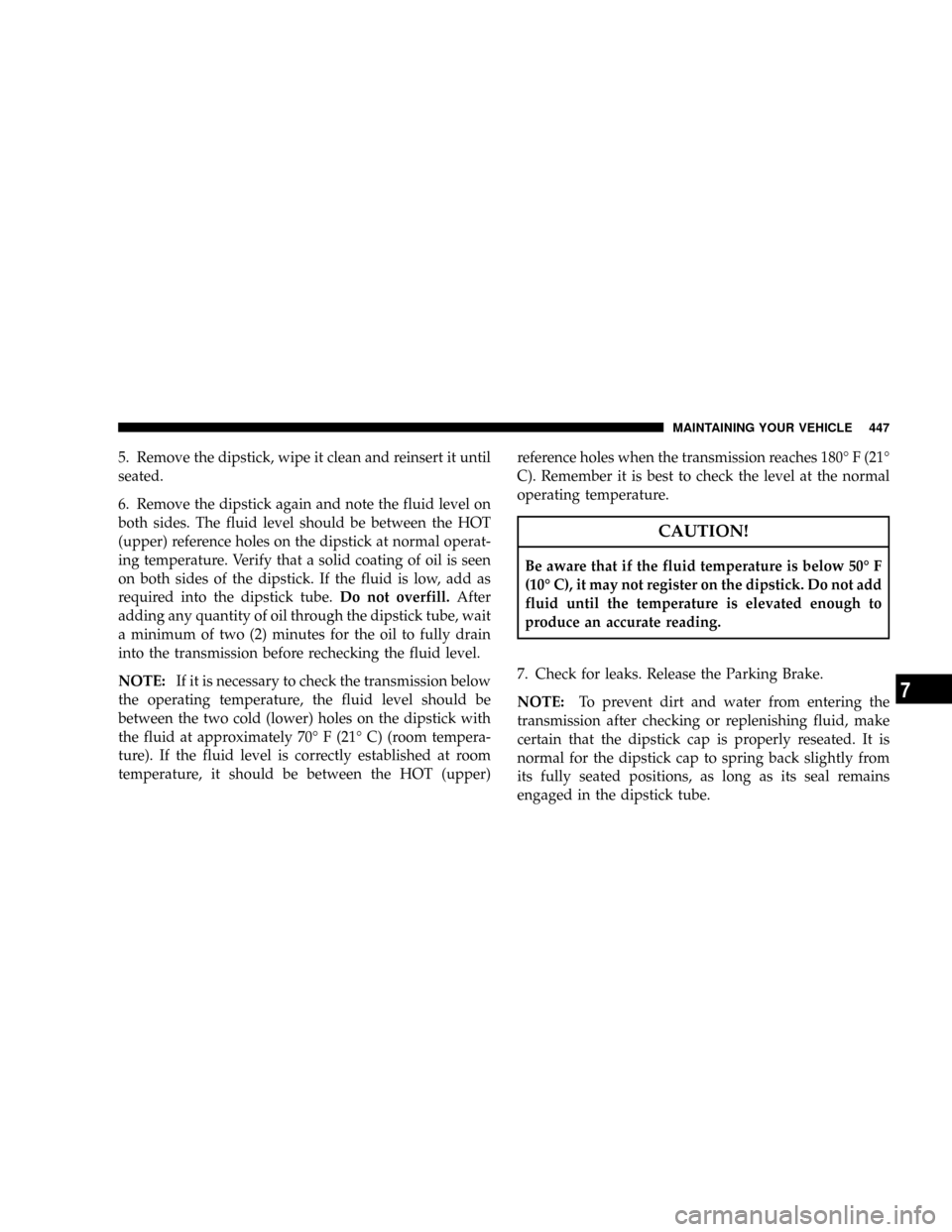DODGE RAM 4500 CHASSIS CAB 2008 3.G Owners Manual
Manufacturer: DODGE, Model Year: 2008, Model line: RAM 4500 CHASSIS CAB, Model: DODGE RAM 4500 CHASSIS CAB 2008 3.GPages: 528, PDF Size: 7.84 MB
Page 441 of 528

heat and mechanical damage. Hard and brittle rubber,
cracking, tears, cuts, abrasion, and excessive swelling
indicate deterioration of the rubber. Particular attention
should be made to examining those hose surfaces nearest
to high heat sources, such as the exhaust manifold.
Insure nylon tubing in these areas has not melted or
collapsed.
Inspect all hose connections such as clamps and cou-
plings to make sure they are secure and no leaks are
present.
NOTE:Often, fluid such as oil, power steering fluid,
and brake fluid are used during assembly plant opera-
tions to facilitate the assembly of hoses to couplings.
Therefore, oil wetness at the hose-coupling area is not
necessarily an indication of leakage. Actual dripping of
hot fluid when systems are under pressure (during
vehicle operation), should be noted before hose is re-
placed based on leakage.NOTE:Inspection of brake hoses should be performed
whenever the brake system is serviced and every engine
oil change. Inspect hydraulic brake hoses for surface
cracking, scuffing, or worn spots. If there is any evidence
of cracking, scuffing, or worn spots, the hose should be
replaced immediately! Eventual deterioration of the hose
can take place resulting in a possibility of a burst failure.
WARNING!
Worn brake hoses can burst and cause brake failure.
You could have an accident. If you see any signs of
cracking, scuffing, or worn spots, have the brake
hoses replaced immediately.
MAINTAINING YOUR VEHICLE 441
7
Page 442 of 528

Brake Master Cylinder ± Brake Fluid Level Check
The fluid level of the master cylinder should be checked
when performing under the hood service, or immedi-
ately if the brake system warning lamp indicates system
failure.
The brake master cylinder has a translucent plastic
reservoir. On the outboard side of the reservoir, there is a
ªMAXº mark and an ªMINº mark (3500 vehicles only)
and a ªFULLº and ªADDº mark (4500/5500 vehicles
only). The fluid level must be kept within these two
marks. Do not add fluid above the full mark because
leakage may occur at the cap.
With disc brakes the fluid level can be expected to fall as
the brake linings wear. However, an unexpected drop in
fluid level may be caused by a leak and a system check
should be conducted.
Refer to Fluids, Lubricants and Genuine Parts for the
correct Fluid type.WARNING!
Use of a brake fluid that may have a lower initial
boiling point, or unidentified as to specification, may
result in sudden brake failure during hard prolonged
braking. You could have an accident.
WARNING!
Overfilling the brake fluid reservoir can result in
spilling brake fluid on hot engine parts and the
brake fluid catching fire.
Use only brake fluid that has been in a tightly closed
container to avoid contamination from foreign matter or
moisture.
442 MAINTAINING YOUR VEHICLE
Page 443 of 528

CAUTION!
Do not allow a petroleum-base fluid to contaminate
the brake fluid. Seal damage and loss of brake
performance may result.
Clutch Hydraulic System
The clutch hydraulic system is a sealed maintenance-free
system. In the event of leakage or other malfunction, the
system must be replaced.
Clutch Linkage
If the clutch pedal linkage begins to squeak or grunt, the
clutch pedal pivot bushings should be lubricated. Refer
to Fluids, Lubricants and Genuine Parts for the correct
lubricant type. Multipurpose Grease, NLGI Grade 2 E.P.
Rear Axle And 4x4 Front Driving Axle Fluid Level
For Models with 9.25 Front Axles and 11.5º Rear Axles
refer to Fluids, Lubricants and Genuine Parts for the
correct lubricant type. For normal service, periodic fluid
level checks are not required. When the vehicle is ser-
viced for other reasons, the exterior surfaces of the axle
assembly should be inspected.
When checking the fluid level (3500 only), the vehicle
should be in a level position. The fluid level should be
1/4º 1/4º (6.4 mm 6.4 mm) below the fill hole on the
front axle. The fluid level should be 1/4º 1/4º (6.4 mm
6.4 mm) below the fill hole on the rear axle.
When checking the fluid level (4500/5500 only), the
vehicle should be in a level position. The fluid level
should be 1/4º 1/4º (6.4 mm 6.4 mm) below the fill
hole on the front axle. The fluid level should be level with
the bottom of the fill hole on the rear axle.
MAINTAINING YOUR VEHICLE 443
7
Page 444 of 528

Drain And Refill
On 3500 vehicles the differential cover must be removed
to drain the axle fluid.
On 4500/5500 vehicles remove the lower bolt to drain the
axle fluid.Follow the appropriate Maintenance Schedule for recom-
mended front and rear axle fluid change intervals.
Lubricant Selection
Refer to Fluids, Lubricants and Genuine Parts for the
correct lubricant type.
NOTE:The presence of water in the gear lubricant will
result in corrosion and possible failure of differential
components. Operation of the vehicle in water, as may be
encountered in some off-highway types of service, will
require draining and refilling the axle to avoid damage.
Limited-Slip Differentials DO NOT REQUIREany
limited slip oil additive (friction modifiers).
NOTE:Slight noise and mild shuddering may be evi-
dent while turning a vehicle with limited slip differential
on concrete or dry pavement. These conditions should be
considered normal operation of the limited slip differen-
tial.
1 Ð 4500/5500 Rear Axle Fluid Fill Plug
2 Ð 4500/5500 Rear Axle Fluid Drain Plug 444 MAINTAINING YOUR VEHICLE
Page 445 of 528

Transfer Case Ð If Equipped
Drain And Refill
Follow the appropriate Maintenance Schedule for recom-
mended transfer case fluid change intervals.
Lubricant Selection
Refer to Fluids, Lubricants and Genuine Parts for the
correct lubricant type.
Fluid Level Check
This fluid level can be checked by removing the filler
plug. The fluid level should be to the bottom edge of the
filler plug hole with the vehicle in a level position.
Manual Transmission Ð If Equipped
Lubricant Selection for 6-Speed Manual
Transmission Ð If Equipped
If it becomes necessary to add fluid or change the fluid,
be sure to use the same lubricant or equivalent. Refer to
Fluids, Lubricants and Genuine Parts for the correct
lubricant type.
Follow the Maintenance Schedule for recommended
transmission fluid change intervals.
Fluid Level Check
This fluid level can be checked by removing the filler
plug. If the level of the lubricant is more than 1/4º below
the bottom of the filler hole while the vehicle is on level
ground, enough lubricant should be added to bring the
level to the bottom of the filler hole.
MAINTAINING YOUR VEHICLE 445
7
Page 446 of 528

Automatic Transmission (Gas Engine Only)
Selection Of Lubricant
Refer to Fluids, Lubricants and Genuine Parts for the
correct lubricant type. It is important that the transmis-
sion fluid be maintained at the prescribed level using the
recommended fluid.
CAUTION!
Using a transmission fluid other than the manufac-
turers recommended fluid may cause deterioration in
transmission shift quality and/or torque converter
shudder. Using a transmission fluid other than the
manufacturers recommended fluid will result in
more frequent fluid and filter changes. Refer to
Fluids, Lubricants and Genuine Parts for correct
fluid type.
Fluid Level Check ± 545RFE Transmission
Check the fluid level while the transmission is at normal
operating temperature 180É F (82É C). This occurs after at
least 15 mi (25 km) of driving. At normal operating
temperature the fluid cannot be held comfortably be-
tween the fingertips.
Procedure For Checking Fluid Level
To properly check the automatic transmission fluid level,
the following procedure must be used:
1. Operate the engine at idle speed and normal operating
temperature.
2. The vehicle must be on level ground.
3. Fully apply parking brake.
4. Place the gear selector momentarily in each gear
position ending with the lever in P (Park).
446 MAINTAINING YOUR VEHICLE
Page 447 of 528

5. Remove the dipstick, wipe it clean and reinsert it until
seated.
6. Remove the dipstick again and note the fluid level on
both sides. The fluid level should be between the HOT
(upper) reference holes on the dipstick at normal operat-
ing temperature. Verify that a solid coating of oil is seen
on both sides of the dipstick. If the fluid is low, add as
required into the dipstick tube.Do not overfill.After
adding any quantity of oil through the dipstick tube, wait
a minimum of two (2) minutes for the oil to fully drain
into the transmission before rechecking the fluid level.
NOTE:If it is necessary to check the transmission below
the operating temperature, the fluid level should be
between the two cold (lower) holes on the dipstick with
the fluid at approximately 70É F (21É C) (room tempera-
ture). If the fluid level is correctly established at room
temperature, it should be between the HOT (upper)reference holes when the transmission reaches 180É F (21É
C). Remember it is best to check the level at the normal
operating temperature.
CAUTION!
Be aware that if the fluid temperature is below 50É F
(10É C), it may not register on the dipstick. Do not add
fluid until the temperature is elevated enough to
produce an accurate reading.
7. Check for leaks. Release the Parking Brake.
NOTE:To prevent dirt and water from entering the
transmission after checking or replenishing fluid, make
certain that the dipstick cap is properly reseated. It is
normal for the dipstick cap to spring back slightly from
its fully seated positions, as long as its seal remains
engaged in the dipstick tube.
MAINTAINING YOUR VEHICLE 447
7
Page 448 of 528

Automatic Transmission Fluid and Filter Change
Follow the Maintenance Schedule for recommended
transmission fluid and filter change intervals.
NOTE:If the transmission is disassembled for any
reason, the fluid and filter should be changed.
Special Additives
The manufacturer recommends against the addition of
any additives to the transmission. Exception to this
policy is the use of special dyes to aid in detecting fluid
leaks. The use of transmission sealers should be avoided,
since they may adversely affect seals.
Automatic Transmission (Diesel Engine Only)
Selection Of Lubricant
Refer to Fluids, Lubricants and Genuine Parts for the
correct lubricant type. It is important that the transmis-
sion fluid be maintained at the prescribed level using the
recommended fluid.
CAUTION!
Using a transmission fluid other than the manufac-
turers recommended fluid may cause deterioration in
transmission shift quality and/or torque converter
shudder. Using a transmission fluid other than the
manufacturers recommended fluid will result in se-
rious damage to the transmission. Refer to Fluids,
Lubricants and Genuine Parts for correct fluid type.
Fluid Level Check ± AS68RC Transmission
Check the fluid level while the transmission is at normal
operating temperature 167É F (76É C). This occurs after at
least 15 mi (25 km) of driving. At normal operating
temperature the fluid cannot be held comfortably be-
tween the fingertips.
448 MAINTAINING YOUR VEHICLE
Page 449 of 528

Procedure For Checking Fluid Level
To properly check the automatic transmission fluid level,
the following procedure must be used:
1. The vehicle must be on level ground.
2. Operate the engine at idle speed for a minimum of 60
seconds and normal operating temperature.
3. Fully apply parking brake and press the brake pedal.
4. Place the gear selector momentarily in each gear
position ending with the lever in P (Park). Make sure the
engine is running at idle speed.
5. Remove the dipstick and determine if the fluid is hot
or cold. Hot fluid is approximately 160É F - 175É F (70É C
± 82É C), Which is the normal operating temperature after
the vehicle has been driven at least 15 miles. The fluid can
not be comfortably held between the finger tips. Only usethe cold region on the dipstick as a rough reference when
doing initial oil level set after transmission rebuild or
transmission refill.
6. Wipe the dipstick clean and reinsert it until seated.
7. Remove the dipstick again and note the fluid level on
both sides. The fluid level should be between the HOT
(upper) reference holes on the dipstick at normal operat-
ing temperature. Verify that a solid coating of oil is seen
on both sides of the dipstick. If the fluid is low, add
MopartA68SRCŸ Automatic Transmission Fluid as
required into the dipstick tube.Do not overfill. Never
use any ATF other than MopartAS68RCŸ Automatic
Transmission Fluid.After adding any quantity of oil
through the dipstick tube, wait a minimum of two (2)
minutes for the oil to fully drain into the transmission
before rechecking the fluid level.
NOTE:If it is necessary to check the transmission below
the operating temperature, the fluid level should be
MAINTAINING YOUR VEHICLE 449
7
Page 450 of 528

between the two cold (lower) holes on the dipstick with
the fluid at approximately 70É F ± 85É F (20É C ± 30É C). If
the fluid level is correctly established at room tempera-
ture, it should be between the HOT (upper) reference
holes when the transmission reaches 160É F - 175É F (70É
C ± 82É C). Remember it is best to check the level at the
normal operating temperature.
CAUTION!
Be aware that if the fluid temperature is below 50É F
(10É C), it may not register on the dipstick. Do not add
fluid until the temperature is elevated enough to
produce an accurate reading. Never use any ATF
other than MopartAS68RCŸ Automatic Transmis-
sion Fluid.
8. Check for leaks. Release the Parking Brake.NOTE:To prevent dirt and water from entering the
transmission after checking or replenishing fluid, make
certain that the dipstick cap is properly reseated. It is
normal for the dipstick cap to spring back slightly from
its fully seated positions, as long as its seal remains
engaged in the dipstick tube.
Automatic Transmission Fluid and Filter Change
To obtain best performance and long life for automatic
transmissions, the manufacturer recommends that they
be given regular maintenance service by an Authorized
Dodge Dealer or Service Center. It is important that the
transmission fluid is maintained at the correct level, and
that it be drained and refilled as specified.
It is important that proper lubricant is used in the
transmission. Refer to Fluids, Lubricants and Genuine
Parts for the correct lubricant type. A filter change should
be made at the time of the oil change.
450 MAINTAINING YOUR VEHICLE